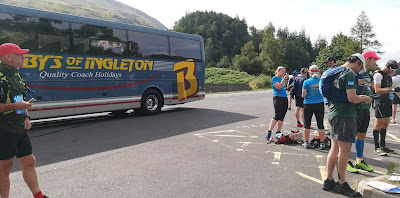Whilst the Lakeland 50 didn’t go well for me (as described in Part 3), there was more to the event than covering 50 miles on foot within 24 hours and thus, even with the 10 hours of digestive distress and my dislike of the experience of Fusedale and Haweswater, overall I had a good weekend. Here are some of the highlights:
- Once past Mardale Head, and the frustrations of the single file, we had a nice walk!
- Whilst many complained that it was too hot, and I certainly wouldn’t have minded more cloud cover, we were incredibly lucky with the weather, getting the coolest day of a hot week, without any threat of rain and with uncommonly dry underfoot conditions.
- The benefit of walking 50 miles, rather than running a goodly chunk of it, is that it’s much easier on the body. Whilst I developed a minor niggle in the back of my left knee late on (whilst Mick suffered with a sore lower back), at no point did I feel like my body wasn’t capable of the distance. Indeed, if someone had told me at the finish that I had to go another 10 miles, I don’t think I would have cried. So, we finished in pretty good shape, feeling strong and not feeling like it was going to take long to recover.
Dawn giving hints of breaking at 0425
The moon about to dip out of sight 30 minutes later
- I’d hoped that we would finish in the early
hours of the morning, but in the event we walked straight through the night.
That had its own highlights, ranging from the quantity of bats flying around
just above our heads as we descended from Garburn (pity there weren’t more to
make a dent in the midge population!), to the impressive sight of lines of
headtorches. At Troutbeck Post Office we succumbed to a bench for a couple of
minutes (it was the first time we’d sat on anything but the ground since we’d
started) and it took me a couple of moments to realise that the line of lights
I could see coming down the hillside were headtorches, not car headlights.
Similarly in Langdale I wondered why all those cars a little ahead and to the
left of us were moving so slowly, before again twigging that they were
headtorches.
It's worth clicking on this for a larger view of the line of headtoches coming down the hillside opposite
- As well as meeting new people we got to catch up with a few TGO Challengers.
- It was truly inspirational to see how good and strong some of the 100 runners looked (they'd been going for 18 hours longer and had covered 55 more miles than us). A special mention goes to Fiona, who I decided is a machine. She was the only person I struggled to catch as I powered over Gatescarth to find Mick and she later passed us on Garburn. Then there were the three 100 chaps who ran past us in the full dark at 3am on some terrain that I couldn't run even in daylight.
- It was a fun weekend in general, with a good festival feel in the camping fields at Coniston. There was even live music, albeit we didn’t attend, choosing instead to have a quiet evening in Bertie.
- The volunteers manning Coniston and all of the Check Points (a whole army of them) are incredible. We didn’t take best advantage of what was on offer at the Check Points, but we still came to appreciate how hard the volunteers were working, putting in a phenomenally long shift to ensure everyone was looked after. I’m sure they all had a significantly more tiring weekend than we did.
- Finally, a word has to be said about how well organised the event was. There’s clearly a massive amount of organisation that goes into an event on this scale (there were 2250 registered entries across both the 100 and the 50; with pre-event attrition, that translated to almost 1700 starters), and whilst I will never be happy about the wait we had at CP1, in all other respects I couldn’t fault anything I saw or experienced.
Will I do it again?
Never say never, but as much as I can see the positives, and would love to attend again in some capacity, I have to conclude that an event this big (as in number of people, not distance!) is not my cup of tea, and nor is setting out at 11.30am - I'm very much an 'early start' sort of a person. As for Mick, he says he wouldn’t mind having another crack at it.
Refueling. These M&S Lemon Curd Iced Buns were superb!





























